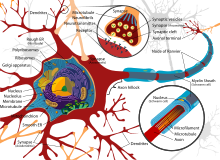General Biology/Tissues and Systems/Nervous System
Nervous System
Composed of tissues designed to integrate sensory information and direct a coordinated response to the environment.
Basic unit of the nervous system is the neuron, a highly specialized cell that uses both electrical and chemical processes to communicate. Neurons "listen" to sensory organs or other neurons, and can simultaneously "hear" from 1 to hundreds of inputs simultaneously. Likewise, a neuron can "talk" to other neurons or cells that can create an action, like muscle cells or glands.
Neurons are outnumbered in the nervous system by glia. Glia were once thought to only play a supportive role in helping neurons survive; today we know that they also are important participants in the communication process. Glial cells include astrocytes, ependymal cells, and a cell that has a macrophage like function. There are also oligodendocytes and Schwann cells that provide a myelin sheath.
Neuron structure[edit | edit source]

- Dendrite will receive information from other axons
- Stoma is the neuron body and contains typical cell parts including the mitochondria and nucleus. This is where neurotransmitters are synthesized.
- Axon hillock is where the cell body and the axon meet.
- Axon is surrounded by myelin.
- Contains nodes of Ranvier
Types of axons include unipolar, bipolar, pseudopolar.
Action potentials results from excitatory stimuli received from the dendrites that results in a signal that travels down the axon. On the cellular level, there is a Na+ influx via channels causing a depolarization of the cell. Once those channels close, the slower opening K+ channels will open resulting in hyperpolarization by the cell.
Synapses
Neurotransmitters allow a chemical signal to be sent from one neuron to the other. Neurotransmitters must bypass a physical gap called the synapse. Examples of neurotransmitters include acetylcholine, epinephrine, and glutamate.
Example : Neuromuscular synapses
Circuits / Nuclei / Ganglia
Central nervous system[edit | edit source]
Central nervous system includes the brain and the spinal cord.
Brain There are four lobes of the brain.
- Frontal lobe - decision making
- Parietal lobe
- Temporal lobe
- Occipital lobe - vision
The areas of the brain are also dedicated to different functions.
- Precentral gyrus
- Postcentral gyrus
Protection The CNS is protected by three layers - the pia mater, the arachnoid mater, and the dura mater. Protection also comes from the circulation of cerebral spinal fluid (CSF). CSF helps to float the brain and also provide nutrients to both the brain and the spinal cord. CSF is synthesized from the choroid plexus of the lateral ventricles. In total, there are four ventricles - 2 lateral ventricles, a 3rd, and 4th ventricle.
Peripheral nervous system[edit | edit source]
The peripheral nervous system is broken down into two sub-systems, the somatic nervous system and the autonomic nervous system.
ANS - Autonomic Nervous System The ANS has two components - parasympathetic and sympathetic.
The sympathetic nervous system is the "fight or flight" or fright response and results in an increased heart rate, increased rate of breathing, and an elevated blood glucose level. There is also decreased digestion. The second neurotransmitter is epinephrine. In this case, the first neuron is short and the second neuron is long.
The parasympathetic nervous system is the rest and digest system.
Drugs must be able to pass the blood brain barrier to have an effect on the CNS. Drugs act by affecting the neuron and how likely it is to fire an action potential.
Stroke occurs when there is a blood clot that goes to the brain and prevent blood flow.